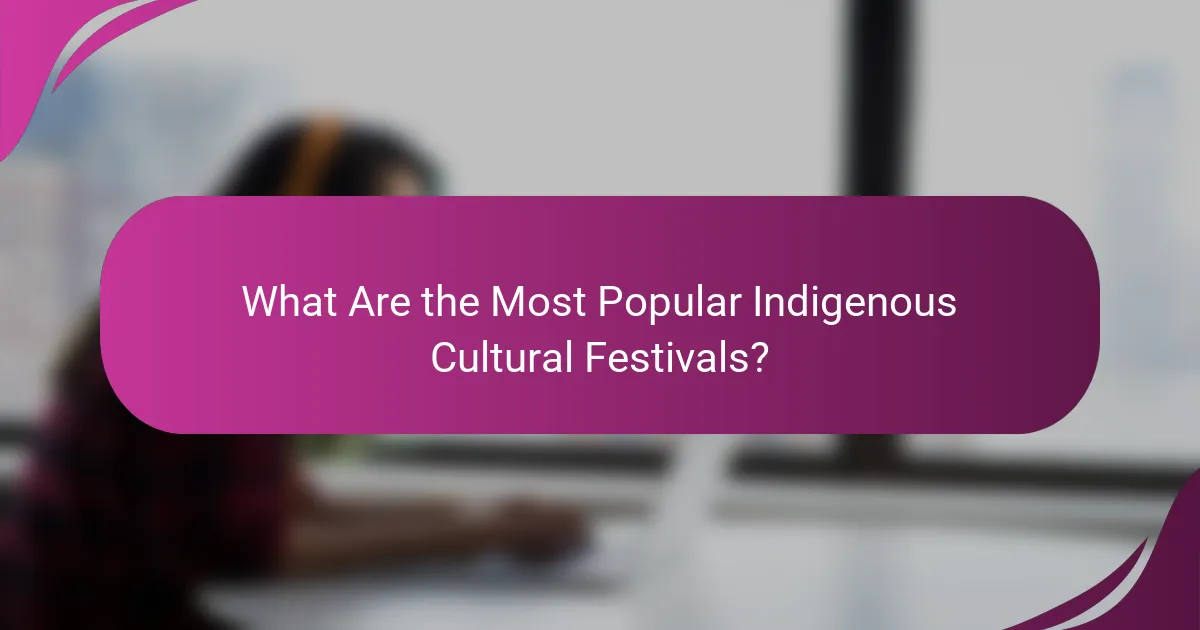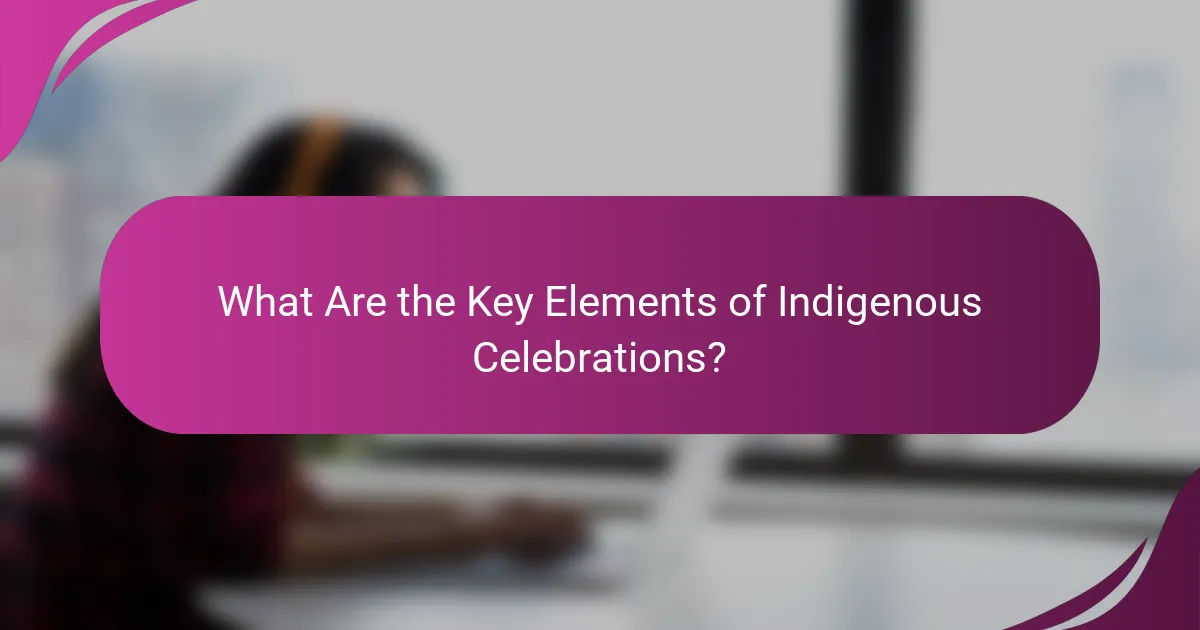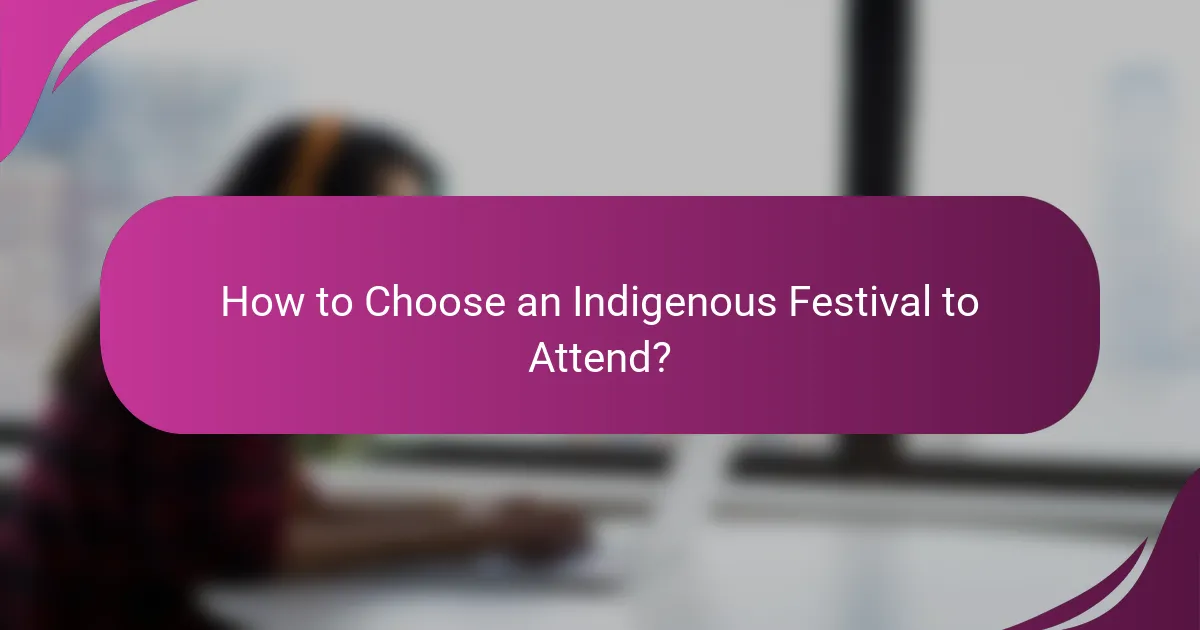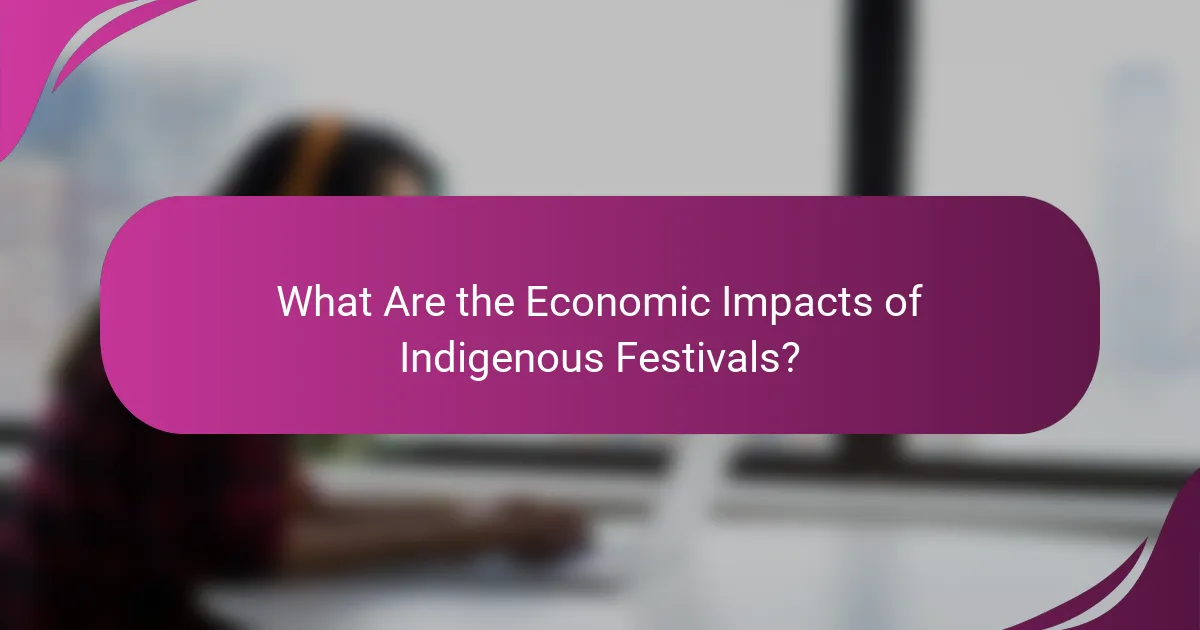Indigenous cultural festivals are vibrant celebrations that honor the rich traditions and heritage of various indigenous communities worldwide. Through music, dance, art, and traditional ceremonies, these events showcase the unique identities and histories of the cultures they represent, fostering a sense of belonging and continuity among participants.

What Are the Most Popular Indigenous Cultural Festivals?
Indigenous cultural festivals celebrate the rich traditions, heritage, and community spirit of various indigenous groups around the world. These festivals often include music, dance, art, and traditional ceremonies that reflect the unique identities and histories of the cultures they represent.
Powwow
Powwows are vibrant gatherings of Native American tribes, featuring traditional music, dance, and crafts. These events serve as a way to preserve cultural heritage and foster community connections. Participants often dress in elaborate regalia, showcasing their tribal identities.
Typically held in the spring and summer months, powwows can vary in size, from small local events to large regional gatherings attracting thousands. Attendees can enjoy various activities, including dance competitions, storytelling, and traditional food vendors.
Naadam
Naadam is a traditional festival celebrated in Mongolia, marking the “Three Manly Games” of wrestling, horse racing, and archery. This festival takes place in July and is a significant event for Mongolian culture, symbolizing national pride and heritage.
During Naadam, participants and spectators gather to witness competitions that showcase strength, skill, and endurance. The festival also includes cultural performances, traditional music, and food stalls offering local delicacies, making it a festive occasion for families and communities.
Holi
Holi, known as the Festival of Colors, is a popular Hindu festival celebrated predominantly in India and Nepal. It signifies the arrival of spring and the victory of good over evil, marked by vibrant colors, music, and dance.
During Holi, people throw colored powders and water at each other, creating a joyful and lively atmosphere. The festival typically occurs in March and includes traditional sweets, bonfires, and community gatherings, promoting unity and friendship among participants.
Day of the Dead
The Day of the Dead, or Día de los Muertos, is a Mexican celebration honoring deceased loved ones. This festival, held on November 1st and 2nd, combines indigenous traditions with Catholic elements, creating a unique cultural event.
Families create altars, or ofrendas, adorned with photos, favorite foods, and flowers to welcome the spirits of the departed. The celebration includes parades, music, and traditional dances, fostering a sense of remembrance and connection to ancestors.
Songkran
Songkran is the traditional Thai New Year festival, celebrated in mid-April. It marks the end of the dry season and the beginning of the rainy season, symbolizing renewal and cleansing.
During Songkran, people engage in water fights, splashing water on each other as a way to wash away bad luck and sins. The festival also includes visiting temples, offering food to monks, and family gatherings, making it a time for reflection and celebration of Thai culture.

How Do Indigenous Festivals Celebrate Heritage?
Indigenous festivals celebrate heritage by showcasing traditional practices, stories, and art forms that reflect the unique cultural identity of each community. These events serve as a vital means of preserving and transmitting cultural values, fostering a sense of belonging and continuity among participants.
Traditional rituals
Traditional rituals are central to indigenous festivals, often involving ceremonies that honor ancestors, nature, and community. These rituals may include dances, prayers, and offerings, each carrying deep cultural significance. For instance, the Sun Dance among Plains tribes in North America is a spiritual event that emphasizes renewal and connection to the earth.
Participants in these rituals often wear traditional attire, which varies by culture and region, enhancing the visual representation of their heritage. Engaging in these practices allows individuals to reaffirm their cultural identity and strengthen community bonds.
Storytelling and oral traditions
Storytelling is a fundamental aspect of indigenous festivals, serving as a means to pass down history, morals, and cultural values through generations. Oral traditions often feature myths, legends, and personal narratives that reflect the community’s worldview and experiences. For example, the Maori of New Zealand use storytelling to convey their ancestry and connection to the land.
During festivals, storytelling sessions may take place around a fire or in communal spaces, inviting participation from all ages. This interactive format not only entertains but also educates, ensuring that cultural knowledge is preserved and appreciated.
Art and craft exhibitions
Art and craft exhibitions at indigenous festivals showcase the creativity and skills of community artisans. These displays often include traditional crafts such as weaving, pottery, and beadwork, which are not only aesthetically pleasing but also carry cultural significance. For example, the intricate designs of Navajo rugs tell stories of the land and its people.
Visitors to these exhibitions can purchase handmade items, supporting local artists and contributing to the economic sustainability of the community. Engaging with these art forms allows attendees to gain a deeper understanding of the cultural heritage and the stories behind each piece.

What Are the Key Elements of Indigenous Celebrations?
Indigenous celebrations are rich in cultural significance and often encompass music, dance, food, and traditional attire. These elements work together to honor heritage, foster community, and preserve unique traditions.
Music and dance
Music and dance are central to indigenous celebrations, serving as expressions of cultural identity and storytelling. Traditional songs often accompany dances that reflect historical events, spiritual beliefs, or seasonal changes.
In many communities, specific instruments like drums, flutes, or rattles are used, each with its own significance. Participation in these activities is encouraged, as they strengthen community bonds and pass down traditions to younger generations.
Food and drink
Food and drink play a vital role in indigenous celebrations, often featuring traditional dishes that highlight local ingredients and culinary practices. Meals are typically communal, emphasizing sharing and togetherness.
Common foods may include roasted meats, stews, and various grains, often accompanied by herbal teas or fermented beverages. These meals not only nourish but also connect participants to their land and ancestors.
Costumes and attire
Costumes and attire are essential in indigenous celebrations, often reflecting cultural heritage and identity. Traditional clothing may be adorned with symbols, colors, and patterns that convey specific meanings or stories.
Participants often wear handmade garments, jewelry, and accessories that showcase craftsmanship and artistic expression. Wearing these outfits during celebrations reinforces cultural pride and continuity, making each event a vibrant display of heritage.

How to Choose an Indigenous Festival to Attend?
Choosing an indigenous festival to attend involves considering factors such as location, accessibility, dates, and the types of activities offered. Prioritize what resonates with your interests and logistical capabilities to ensure a fulfilling experience.
Location and accessibility
When selecting an indigenous festival, the location plays a crucial role. Consider how far you are willing to travel and the available transportation options. Some festivals are held in remote areas, which may require additional planning for travel and accommodation.
Accessibility is also important; check if the venue is equipped for individuals with disabilities. Look for festivals that provide clear information on how to get there and any transportation services available, such as shuttles or public transit options.
Festival dates and duration
Festival dates can vary widely, often depending on cultural calendars and seasonal events. Many indigenous festivals take place during specific times of the year, such as harvest seasons or significant cultural anniversaries. Research the timing to align with your schedule.
Additionally, consider the duration of the festival. Some events last only a day, while others may span several days or even weeks. Longer festivals might offer a wider range of activities and experiences, so weigh your time availability against what each festival offers.
Activities and attractions
Indigenous festivals typically feature a variety of activities, including traditional performances, art exhibitions, workshops, and food stalls. Look for festivals that highlight cultural practices you are interested in, such as dance, music, or crafts.
Attractions can also include educational sessions about indigenous history and heritage. Check the festival’s schedule in advance to plan which events you want to attend, ensuring you make the most of your experience.

What Are the Economic Impacts of Indigenous Festivals?
Indigenous festivals significantly contribute to local economies through various channels, including tourism, business support, and job creation. These events not only celebrate cultural heritage but also stimulate economic activity in surrounding communities.
Tourism revenue
Indigenous festivals attract visitors from both local and international markets, generating substantial tourism revenue. Attendees often spend on accommodations, food, and souvenirs, which can lead to an influx of cash into the local economy.
For instance, a well-attended festival can bring in thousands of tourists, resulting in increased hotel bookings and restaurant patronage. Communities may see tourism revenue rise by tens of percent during festival periods.
Local business support
Local businesses benefit directly from the increased foot traffic and spending during indigenous festivals. Vendors, artisans, and service providers often see a boost in sales as festival-goers seek unique products and experiences.
Many festivals include marketplaces that showcase local crafts and foods, providing a platform for small businesses to thrive. This support can be crucial for sustaining local economies, especially in rural areas where economic opportunities may be limited.
Job creation
Indigenous festivals can lead to job creation in various sectors, including event management, hospitality, and retail. Temporary positions may arise in the lead-up to and during the festival, providing employment opportunities for community members.
Additionally, the long-term effects of increased tourism can result in permanent job growth in related industries. Communities may experience a rise in job openings by a small percentage each year following successful festivals, contributing to overall economic stability.

How Do Indigenous Festivals Promote Cultural Awareness?
Indigenous festivals play a crucial role in promoting cultural awareness by showcasing traditional practices, art, and community values. These celebrations foster understanding and appreciation among diverse audiences, bridging cultural gaps and preserving heritage.
Celebration of Traditions
Indigenous festivals often highlight unique traditions through music, dance, and storytelling. These elements serve as a living archive of cultural history, allowing participants to experience and engage with the customs that define a community. For example, the Pow Wow in North America features traditional dances and songs that reflect the heritage of various tribes.
Community Engagement
These festivals encourage community participation, bringing together individuals from different backgrounds to celebrate shared values. Engaging local populations fosters a sense of belonging and strengthens social ties. Events like the Naadam Festival in Mongolia not only showcase traditional sports but also unite communities in a collective celebration of identity.
Educational Opportunities
Indigenous festivals provide educational experiences for attendees, offering workshops and demonstrations that teach about cultural practices. This hands-on approach helps demystify traditions and encourages respect for Indigenous knowledge. For instance, craft workshops at festivals can teach visitors about traditional weaving or pottery, promoting a deeper understanding of the skills involved.
Preservation of Language and Art
Language and art are vital components of Indigenous identity, and festivals often incorporate these elements to promote their preservation. Through performances and exhibitions, attendees can witness the beauty of Indigenous languages and artistic expressions. Events like the Festival of Pacific Arts showcase diverse art forms, helping to keep these cultural expressions alive for future generations.
